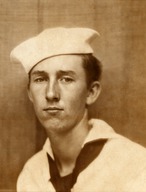
|

|
|
|
|
Homer was born in Many, Louisiana on a farm his father sharecropped. He was one of five children of Robert Lee Downs and Artie Elizabeth Lee Downs. "Hard," he says of growing up on a farm during the Depression. The family traveled by wagon or buggy. They heated their house with a fireplace and lit it with kerosene lamps. His mother cooked on a wood stove. They began each day with a breakfast of cornbread and eggs. Homer quit school in the seventh grade to help on the farm. He entered the Civilian Conservation Corps (CCC), stationed in Louisiana where he planted trees and helped build roads. Six months later he joined the U.S. Navy in 1943. His choice of the service, he said, was easy. Representatives of the U.S. Marine Corps and the U.S. Army came to his CCC camp and "talked about these foxholes," he recalls. "The Navy came around and they said, `You've got a good warm bunk as long as you keep it afloat.' I said, `That's for me.'" He completed boot camp in San Diego, then was assigned to LST 479 as a boatswain's mate. He sailed to Pearl Harbor, then to the Gilbert Islands for the invasion of Tarawa, where his LST off-loaded men and equipment as the battle raged around it. Driving a Higgins boat, Homer transported casualties from the beach to a hospital ship. After two weeks in the Gilbert Islands, LST 479 headed back to Honolulu for re-supply, then sailed to New Guinea. "There were seven ships unloaded ammunition all day and night," he says. "The Japs came along strafing the beach and blew every bit of it up. We were stuck on the beach and had to get another ship to help us get off." Returning from New Guinea, the LST was caught in a typhoon with "eighty- or ninety-foot waves," he recalls. He next served in campaign for the Philippines, where he went on liberty one day and walked into "this little ol' bar, and it was the President of the United States sitting there. John F. Kennedy," he remarks. "I didn't think he was a millionaire at the time I saw him." At other times, the ship went weeks without touching land. Once, Homer recalls, LST 479 was at sea for ninety-six days without seeing land. "We were down to coffee, marmalade, and bread. And I don't like marmalade now," he recalls. Homer participated in the battle for Guam, then Iwo Jima. After that battle LST 479 made "milk runs," picking up supplies and moving men. He was in Pearl Harbor when the war ended. "We had a party," he recalls. He returned to the States in October of 1945 and was discharged on January 13, 1946 in New Orleans. He worked a few years in Galveston, then returned to Many, where he married Nancy Sepulvedo on December 6, 1950. (They would have two children, five grandchildren, and four great-grandchildren.) The couple lived in New Orleans for two years, then moved to Shreveport where Homer went to work for Mid-Continent Steel for twenty-five years. He has attended ten reunions of his LST crew. |


